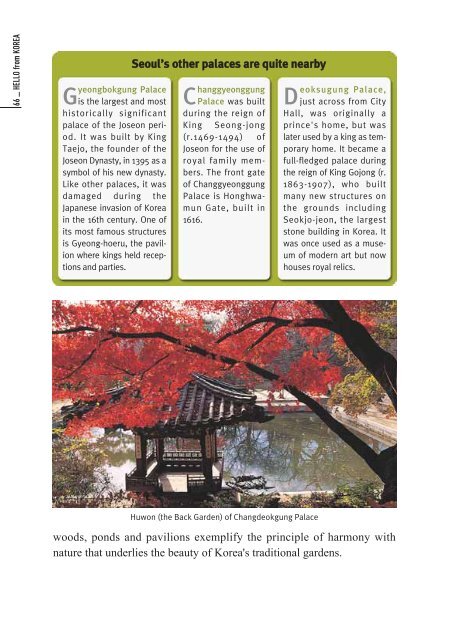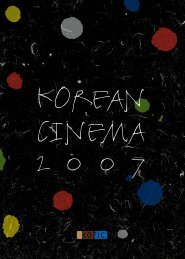HELLO from KOREA
Hello-Eng(3.3) - Korea.net
Hello-Eng(3.3) - Korea.net
- No tags were found...
You also want an ePaper? Increase the reach of your titles
YUMPU automatically turns print PDFs into web optimized ePapers that Google loves.
66 _ <strong>HELLO</strong> <strong>from</strong> <strong>KOREA</strong><br />
Gyeongbokgung Palace<br />
is the largest and most<br />
historically significant<br />
palace of the Joseon period.<br />
It was built by King<br />
Taejo, the founder of the<br />
Joseon Dynasty, in 1395 as a<br />
symbol of his new dynasty.<br />
Like other palaces, it was<br />
damaged during the<br />
Japanese invasion of Korea<br />
in the 16th century. One of<br />
its most famous structures<br />
is Gyeong-hoeru, the pavilion<br />
where kings held receptions<br />
and parties.<br />
Seoul’s other palaces are quite nearby<br />
C hanggyeonggung<br />
Palace was built<br />
during the reign of<br />
King Seong-jong<br />
(r.1469-1494) of<br />
Joseon for the use of<br />
royal family members.<br />
The front gate<br />
of Changgyeonggung<br />
Palace is Honghwamun<br />
Gate, built in<br />
1616.<br />
Deoksugung Palace,<br />
just across <strong>from</strong> City<br />
Hall, was originally a<br />
prince's home, but was<br />
later used by a king as temporary<br />
home. It became a<br />
full-fledged palace during<br />
the reign of King Gojong (r.<br />
1863-1907), who built<br />
many new structures on<br />
the grounds including<br />
Seokjo-jeon, the largest<br />
stone building in Korea. It<br />
was once used as a museum<br />
of modern art but now<br />
houses royal relics.<br />
Huwon (the Back Garden) of Changdeokgung Palace<br />
woods, ponds and pavilions exemplify the principle of harmony with<br />
nature that underlies the beauty of Korea's traditional gardens.
















